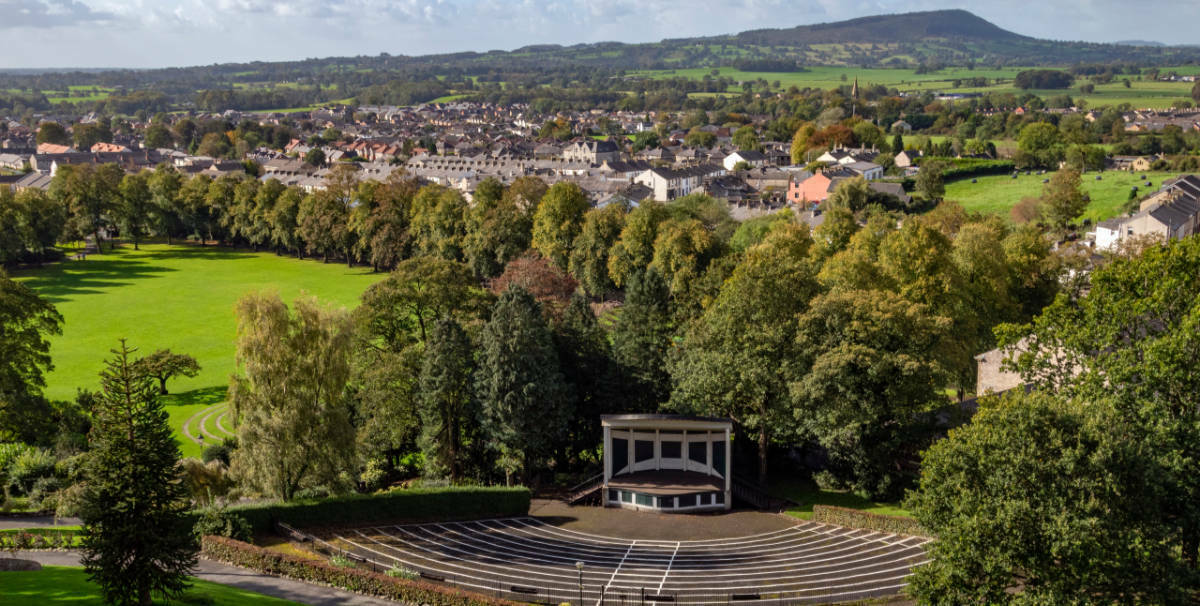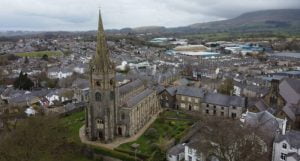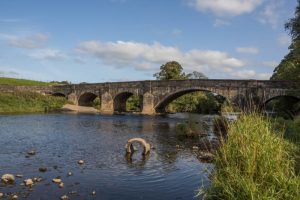
Ribble Valley’s finest tourist base for exploring the Lancashire countryside.
Looking for your new favourite family holiday destination? Clitheroe, up in Lancashire, is the place that long-lasting memories are made of. With a population just shy of 20,000 people, this lovely town is large enough to cater to all your holiday needs, yet still small enough to carry that quaint English charm that makes you fall in love with a place.
Settle yourself in for another five minute tour of a town in England. We have dozens of them, and they are all exceptionally entertaining. If Clitheroe isn’t for you, see if you can spot your own town here. Otherwise put the kettle on and get ready for a good old read.
The Early Days of Clitheroe
Clitheroe is on the east bank of the River Ribble, inside the Ribble Valley. This gorgeous area of countryside saw its heyday in the Norman era, when a friend of the king’s built a tiny castle here. A Roman road cuts through the town heading north and may have attracted some travellers form the road. Although the Medieval castle is the highlight of the town, Clitheroe has a rich history that starts with the Anglo-Saxons picking a rocky hill to live on.
We know that this area of Lancashire wasn’t officially defined until well after the Norman Conquest. Up until then, the town was nothing but a selection of farmlands, some woodland, meadows, and the occasional settlement. The area remained largely so until the Normans came and tried to take control. Nothing will bring a community together faster than an occupational force.
Back in those days, lords split the land into portions called ‘honours’. You may still hear the title of Honour of Clitheroe. Henry de Lacy granted the first charter to the town in 1147.
The Medieval Era
Clitheroe is on the southern edge of the picturesque Bowland Fells, and on the edge of the forest. The site must have had a few houses on it, enough for Robert de Lacy to build his castle on. The lands originally belonged to Roger de Poitou, who the king gifted much of the area along the Ribble. De Poitou later lost these lands after involving himself in a plot to kill Henry I. The lands went to de Lacy, who built a small keep on it. The castle passed to Thomas, the Earl of Lancaster, and it remained in their family until the Restoration.
The castle belonged to the 1st Duke of Albemarle, the House of Montague, and the 1st Duke of Gloucester. It’s probably haunted by at least two of them. In fact, there is a local legend about a vengeful spirit which haunts the steppingstones across the fjord in the river. This spirit steals away one soul every 7 years by drowning them. Don’t panic, we did a quick search, and we can’t find any records which say it’s true.
The Demise of the Castle
During the medieval period, the once important town of Clitheroe faded into a sleepy working town. The castle fell into decay and, by 1602, historians note that it was ready to collapse. In 1644, the town of Clitheroe saw engagement in the English Civil War. Prince Rupert garrisoned it, even though parts of the ceiling could fall on him at any moment. The prince abandoned the castle to choose a fight on Marston Moor, instead. The castle was brought down in 1649 by the Parliamentarians, who didn’t want it used against them.
Townsfolk once again repaired their beloved castle enough for it to act as the administrative centre for Blackburnshire. In 1822 a town hall replaced it. The town council bought it officially after WWI so that they could use it as a site to honour the dead.
There was a scandal here in the local church in 1520. A local miller stood accused of charging too high a toll. While the body of Christ was being given, he threw himself into the dirt and refused to look at the priest. Of course, they had to punish him in case he was a heretic. He was fined 6 shillings and 8 pence.
Fun Facts about Clitheroe in Lancashire
Whenever we take a local tour of a town, we like to dig up all the dirt that we can find. Usually, that dirt is gossip-shaped, local legend-formatted, or general trivia orientated. Here are all the fun facts we could dig up about Clitheroe:
- Much of the town’s fame is due to the Norman castle. This hold was the second smallest of its kind in England. It belonged to Robert de Lacy, who built it in 1186. The castle has a motte and a curtain wall, and only part of it is still standing.
- The annual Clitheroe Food Festival, held in August, attracts upwards of 80 different food vendors. The town holds a festival in spring every year, running since 1997.
- In 1102, Roger of Poitou, one of the castle’s former owners, helped in a rebellion against Henry I. Roger owned lands all along the River Ribble. The king stripped him of his land and titles as a result. The king gave the lands to Stephen of Blois, instead.
- The castle suffered a blow during Cromwell’s reign. The blow punctured a hole in the side that you can still see now. Local legend likes to tease tourists that the Devil through a boulder from nearby beauty spot Pendle Hill, which hit the castle but failed to topple it.
- The keep in Clitheroe Castle is only 20 feet squared. We wonder why he built it so small. The Normans built many castles throughout the north of England. These castles were there to keep control over the local unruly populaces.
- Clitheroe is the site of the Battle of Clitheroe, fought between the English and the Scots in 1138.
- Legend has it that a ghost haunts the river, at least one haunts the castle, and another abides in a local manor house. Clitheroe appears in several lists of the most haunted places in Britain. Keep an eye out for forlorn workers and ghastly ladies roaming the grounds.
And on that spooky note, let’s get back to the good stuff. Business really picked up in Clitheroe during the industrial revolution. Word on the street, though, is that the town was never more important than it was back in the days of the tiny castle.
The Ghosts of Clitheroe
Let’s continue with the ghost stories and relay the tale of Peg O’ Nell. Poor Peg was a servant to the master of the house at Waddow Hall. Now a girl guide centre, Waddow Hall used to play home to the Tempest family. Built in 1267, this hall remained a personal residence all the way up to the late 17th century. Just before the Industrial Revolution reached this part of the country, legend tells the story of two ghastly mishaps in Waddow Hall.
The first is that Peg O’ Nell became pregnant with her master’s child. His wife was murderous in her rage. She pushed Peg down an open well on the property. Now dead set on revenge, Peg haunts the area, claiming a victim every few years.
The grounds of Waddow Hall still sport that same well. In addition, they feature a headless statue near the well. The story goes that the statue used to be inside the house. Servants refused to work in the same room as it, calling it a thing of the Devil. Eventually, the Tempest family hauled the statue outside to stop it disrupting the household. Did it ever have a head? We don’t know.
The Lancashire Witches operated in this area and one, Margaret Pearson, was brought to trial here in 1612. Her sentence was to stand in the Pillory in Clitheroe and other towns.
On with the real stuff…
The Industrial Revolution
Clitheroe and the surrounding areas didn’t begin the industrial era on the best footing. In the late 1700s, records show Bolton of Bowland ran a workhouse for 10 ‘inmates’. By 1790, the premises were expanded. In 1830 a new workhouse at Holden made up the shortfall. Another added at Aighton in 1817 made three in the local area.
The town’s population was 23,168 in the 1831 census. The Clitheroe Poor Law began in 1837. Reviews by the board saw that the rooms were unimpressive and not fit for habitation by today’s standards. The Holden workhouse treated the elderly, infirm, and lunatics, by then. In 1873, the Clitheroe Poor Law board erected a new workhouse for 200 inmates, including a hospital.
At the beginning of the industrial era, lime burning, and quarrying were two of the town’s trades. Cotton manufacturing became dominant in the early 1800s as mills on the river could weave it into thread. There were factories in town, paper mills, and breweries. There were a few acres of arable farmland near the town. In 1874, it received a public hall. In 1864, a local volunteer police force began. During this time there was a sulphur spring in town and races were held here in summer. These have since vanished.
The Modern Town
In the early 20th century, Clitheroe involved itself heavily in the war effort. Since it was already a centre of industry, engineers working in the Rover Company factory consulted with Rolls-Royce engineers. Together, they created the jet engine within Clitheroe.
Air Commodore Frank Whittle invented the jet engine here. The town council named parts of the town after him. Officials had Whittle’s Close built on top of the first testing grounds for the jet engine.
You will find the monument for the men lost in the wars on the castle grounds. The lone soldier and his rifle stand vigil with a view of Pendle Hill. There are 324 names recorded from the First World War, and 72 names recorded as lost during the Second World War.
The buddy regiment scheme and trench warfare meant higher losses of life the first time around. We can also attest the drop in names to the drop in population of Clitheroe, which started to ease off with the decline in the coal industry.
Modern Clitheroe attracts big businesses from all over Britain. Its industrial heritage extends to cover brands like the original Tarmac, Hanson Cement, and Dugdale Nutrition. The town is a haven for industrial manufacturing, as well as a haven for tourists exploring the nearby Bowland Forest.
The area mixes industry with tourism in a unique way. You don’t stand in the town centre and imagine cement is being made in the industrial park down the road. Instead, you visit the castle, look out over Pendle hill, and admire the raw beauty of our land.
Famous People from Clitheroe
We always love to dig up the dirt on the rich and famous in the area. Clitheroe might not have many famous faces littering the streets, but the residents of this hard-working town have made their mark over the years. Here are some of the famous people from Clitheroe you should know about, even if you don’t meet them in the supermarket:
- Lots of footballers, including Adam Barton, Jimmy Crabtree, Alan Fletcher, and Jack Keenan.
- Lots of cricketers, including Dick Harrison, George Hudson, and William Blackburn.
- English jazz pianist Stan Barker is a Clitheroe man.
- Geeta Guru-Murphy was born here, an English journalist possibly related to Krishnan.
- The poet and sculptor Jeff Nuttall lived here, though he sadly passed away in 2004.
- Yorkie, one of the guys from 90s band Space, was from here.
So there have been famous people from Clitheroe in every walk of life.
Best Attractions in Clitheroe
In this section, we cover the best things to see and do in town. Whether you are in Clitheroe for a short break or there for a fortnight’s holiday, here are the attractions to look out for.
Historic Sites
Clitheroe Castle is the number one attraction in the area. We have gone through all the history of it already, but let’s do a quick recap for those that skipped to the attractions. Clitheroe Castle opened in the 1100s when one of King William’s friends built it. It passed hands countless times over the years, and now belongs to the town council. They put the war memorial on the grounds. It’s a lovely, ruined building with lots of ghosts attached. Seriously, go back and read the history. You missed some cool stuff.
A second historic site in town is Browsholme Hall. This countryside manor and hall has a Tithe Barn attached. Billed as Lancashire’s oldest ancestral home, this manor house is out in the centre of the forest. It’s belonged to the family for 14 generations and counting.
St Mary Magdalene Church

Image: Matt_Turner/Shutterstock.com
We will caveat the historic reference to this fine church by adding it has been substantially rebuilt on numerous occasions. However, it remains an impressive sight. The origins of the site probably date back to Norman times and there are definitive records of a church here from 1122.
It was substantially rebuilt in the fifteenth century and again needed substantial renovations in 1979 following a fire. The impressive spire was also replaced in 2012, however, it has been done in keeping with the original style.
It is active in the community and has a nice website that you can check out here.
Landmarks
Edisford Bridge is a historical landmark that now has its own car park, holiday park, and picnic area. This medieval bridge opened in 1339. It was widened in the 1800s and still operates today. It features the old sandstone archway system that would have been a true feat of engineering back in its day. Locals use the lovely riverside walkway as a place to play in the river come summertime.

Image: Matt_Turner/Shutterstock.com
Bellmanpark Lime Kiln opened in 1877, towards the end of the lime-burning era in Clitheroe. The site belonged to Cater & Rowe’s lime works, which fell into disrepair and eventually made the ‘Monuments at Risk’ list in 2014. Volunteers cleared the area and conservation engineers have brought it up to modern safety standards. It’s a good place to get an insight into the industrial heritage of Clitheroe.
Galleries
One of the biggest galleries and museums in the area is inside the college. Stoneyhurst College is an architectural masterpiece nearby Clitheroe. Visit to take Insta-worthy pictures or to browse the amazing library. They have thousands of artefacts and an even larger collection of artworks and sculptures.
Although not strictly a gallery, you can go antiquing here in Clitheroe. Visit Driscolls Antiques Ltd to browse any day of the week.
If you prefer small-time art galleries owned by independent business owners, then check out the Keep. Run by Julia and Tony, this is a friendly local art shop with loads to offer.
Museums
There is a small museum inside the castle that tells you about the local history. Added to this, you will find the museum inside Stoneyhurst College. However, Clitheroe is a rather artsy place, with a third gallery named the Platform Gallery offering further opportunities to buy some local artworks. This space changes artists every three months, so you can see a different exhibit every time you visit.
Sports
The local football team are Clitheroe FC. You can find them on Shawbridge Street. There is also the Low Moor Football Club and Clitheroe Rugby Club for sports teams in Clitheroe.
Since this is an English town, you have your choice of golf clubs. Look for the Clitheroe Golf Club just outside of town. There are others nearby to choose from, including Mytton Fold and Whalley.
Recreation
The local theatre is called The Grand, and it is as big as it sounds. Catch a live gig here, see a show, enjoy the opera, you name it. Check what’s on when you are in town to make sure you don’t miss out.
Get out and about and follow the Ribble Valley Sculpture Trail. This series of local landmarks produced by native artists allows you to get out and really see the valley. This is something anyone able to hike can enjoy for free, any day of the week. Launched in 1993, the trail features 20 permanent works of art.
Outdoor Attractions
Part historic site and part outdoor fun, Whalley Abbey is nearby Clitheroe. Now still in operation, this former Abbey offers a place for quiet contemplation and spiritual reflection. The Whalley Abbey gatehouse is a ruinous 14th-century structure near the former Cistercian abbey. It is well worth the visit. They have an onsite café, too. We suggest you visit the abbey, the gate, and the café, all in one day.
Shopping
There are three shopping centres in the town for you to use, although the town centre contains other stores. You can visit the Mall in nearby Blackburn. You can head to the Fishergate Shopping Centre on the north end of town, so you can visit the Heskin Hall Shopping Village to the south, near Bolton.
You will find Clitheroe Country Market every Tuesday in the Reform Church. They have plenty of fresh fruit and veg and you can even get a cheap cuppa and a cake. The market has been running since 1949.
Other Notable Nearby Tourist Sites
There are loads of things to see and do out in the surrounding countryside. Lancashire is full of interesting towns to explore. Try and see the following sites if you are in town for longer than a couple of days:
- Blackpool is in Lancashire. It’s a bit of a drive, but it’s worth it for the Zoo, the Tramway, and the Blackpool Tower.
- Go and visit Lancaster Castle.
- See the old Burnley town of industry.
- Visit the Royal House of Lancaster, the birthplace of the Industrial Revolution.
- Visit Planet Ice or Dart Zone in Blackburn.
- Learn about the East Lancashire Railway.
This area of the country is brimming with things to see and do. Get out there and enjoy it. You owe it to your English ancestors.
How to get to Clitheroe?
Now that you are up to date on the history and know what to see and do about town, we can cut to the chase – how do you get to Clitheroe?
By Road
Clitheroe is off the M65. Follow the A59.
By Rail
Look for Clitheroe Station on the Northern Railway line.
By Air
Your nearest airport is Leeds Bradford international.
By Sea
This area is landlocked.
Five Minutes Spare
If you enjoyed this little jaunt into Clitheroe, then we have a site that you might like. Come visit our webpage or give us a follow on Facebook.
Header Image: Steve Allen/Shutterstock.com





